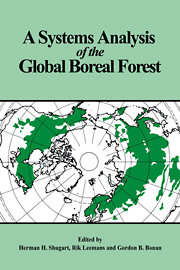Book contents
- Frontmatter
- Contents
- List of contributors
- 1 Introduction
- Part 1 Processes in boreal forests
- Part 2 Patterns in space and time in boreal forests
- Introduction
- 7 The transition between boreal forest and tundra
- 8 The southern boreal–northern hardwood forest border
- 9 Transitions between boreal forest and wetland
- 10 Remote sensing technology for forest ecosystem analysis
- 11 The nature and distribution of past, present and future boreal forests: lessons for a research and modeling agenda
- Part 3 Computer models for synthesis of pattern and process in the boreal forest
- References
- Index
Introduction
Published online by Cambridge University Press: 12 January 2010
- Frontmatter
- Contents
- List of contributors
- 1 Introduction
- Part 1 Processes in boreal forests
- Part 2 Patterns in space and time in boreal forests
- Introduction
- 7 The transition between boreal forest and tundra
- 8 The southern boreal–northern hardwood forest border
- 9 Transitions between boreal forest and wetland
- 10 Remote sensing technology for forest ecosystem analysis
- 11 The nature and distribution of past, present and future boreal forests: lessons for a research and modeling agenda
- Part 3 Computer models for synthesis of pattern and process in the boreal forest
- References
- Index
Summary
Introduction
The perception that there is a relationship between the patterns observed on a landscape and the set of physical and biological processes that generate those patterns is central to modern ecology. The concept was perhaps best elucidated in the classic 1947 presentation of A. S. Watt but was also an important construct in earlier papers by Watt (e.g. 1925) and others. The basic premise is to view an ecosystem as a working mechanism (Tansley 1935; Watt 1947). Such a mechanism, as a consequence of its internal interactions and interactions with the environment, produces the patterns that we see in nature. When one inspects Tansley's (1935) original definition of the ecosystem, one finds the same concepts that one sees in hierarchy theory today (Allen & Starr 1982; Allen & Hoekstra 1984; O'Neill et al. 1986; Urban, O'Neill & Shugart 1987).
Of course, the Watt–Tansley ecosystem paradigm has been reintroduced as a major ecosystem construct in ecological studies. One conspicuous reintroduction of these concepts was Whittaker's (1953) review, which used the Watt pattern-and-process paradigm to redefine the ‘climax concept’. These same ideas are also found in ecosystem concepts developed by Bormann & Likens (1979a,b) in their ‘shifting-mosaic steady-state concept of the ecosystem’, as well as in what Shugart (1984) called a ‘quasi-equilibrium landscape’. Given the richness of concepts developed by ecologists in the first half of this century, it is foolish to propose that any idea is new, but we are now in a position to extend the pattern-and-process paradigm in what may be fundamentally important ways.
- Type
- Chapter
- Information
- A Systems Analysis of the Global Boreal Forest , pp. 192 - 195Publisher: Cambridge University PressPrint publication year: 1992
- 1
- Cited by



